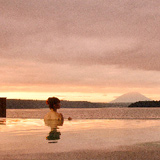At the Toya-Usu UNESCO Global Geopark you can learn about how this land has evolved over 110,000 years of repeated volcanic activity to what it is today.
Ride the Usuzan Ropeway and see the panoramic view from the summit. Hike through the trails and footpaths and feel the heartbeat of the earth with each step you take. Visit the science museum to learn about volcanic disasters and disaster response strategies. This park sits on one of the many volcanically active areas of Japan, and it is an invaluable place of learning in the world.

The catchphrase of the Geopark is ""Living together with the ever-changing Earth."" These eruptions, which have repeated over and over since ancient times, have greatly changed the landscape, giving rise to Lake Toya and Mt. Usu, and these changes continue to this day. Let’s talk a bit about the history of those who have lived alongside the volcano, take in their wisdom in coping with volcanic disasters, and see how volcanic activity has given rise to these earthly blessings.
Mt. Usu, which overlooks southern shore of Lake Toya, is a volcano that is still active to this day. From the foot of Mt. Usu to near the summit you can find numerous vents, marking the many eruptions that have taken place.
It is said that Mt. Usu was formed about 20,000 years ago. Between 1663 and 2000 there have been 9 eruptions, and the resulting landscape being changed every few decades.
Showa-shinzan is also a lava dome formed from what was once a wheat crop farmland.
The power of the volcano and the earth is fascinating, but let’s pay more attention to the fact that people have lived near this active volcano since ancient times.
A number of archeological sites have been found around Mt. Usu that show that the Jomon and Ainu cultures have prospered here.



Volcanic activity can cause disastrous effects such as earth deformation, pyroclastic flows, and mudflows. Mt. Usu has also caused many disasters and sacrifices, and the many volcanic remains remind people this incredible threat.
At present, Mt. Usu erupts once every few decades. The most recent was at the foot of the mountain in 2000. The eruption occurred near a national roadway and along many houses. New vents were discovered not far from the other mountains, but amazingly, there were no deaths.
There were warning signs of a possible eruption. The residents were evacuated in advance, leading to no injuries or deaths, despite even a bridge being melted away.
You can learn about the magnitude of the disaster by walking along the trails of the Kompira Crater Disaster Site or the “Fun’ka Kiko” Eruption Archeology Park.
""Living with the volcano"" is the culmination of wisdom, knowledge and learning gained from the hardship and sacrifice of the people who live here.



Thanks to the many repeated eruptions of Mt. Usu, it has brought not just beauty to the landscape, but also many blessings, such as fertile land fit for agriculture, abundant seafood, and lots of hot springs.
First, let’s talk about food.
The eruption causes soil to mix with volcanic ash and pumicite. This mineral-rich soil drains well and is excellent for growing fruit. The volcanic flat lands around Lake Toya is very suitable for cultivating vegetables.
Fresh seafood is also abundant. The bay of Uchiura-wan, with its rugged terrain, attracts many fish and shellfish. The terrain of this bay is due to the eruption of Mt. Usu, about 10,000 years ago.
In addition, dairy farming and raising of cattle, pigs, and chickens, are made possible by the land’s excellent pasture and water.
It is a treasure trove of produce. It is said that a full course meal can be made using only ingredients produced from within the Geopark.



While the Geopark is a paradise that offers a wide variety of hot springs, these hot springs are the result of volcanic activity – a blessing from the earth.
Toyako Onsen and Sobetsu Onsen became possible in 1910. The eruption of Mt. Usu brought magma closer to the water, and the area became a hot spring source.
Toyako Onsen sees many tourists all-year round as one of the leading hot springs in Hokkaido. As well, many other hot springs also provide a therapeutic experience.

